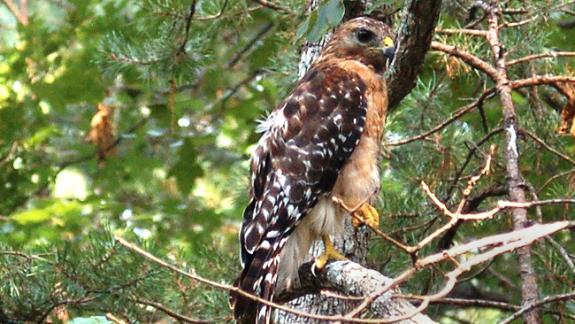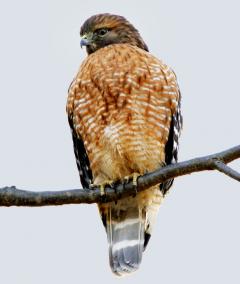Red-Shouldered Hawk
The Red-shouldered hawk (Buteo lineatus) is a forest hawk listed as an endangered species in New Jersey. It is not highly visible and can go undetected in wetland forests where it lives and nests.
 Red-shouldered hawk.
Red-shouldered hawk.
Hawks, eagles, and owls are known as raptors or birds of prey. Some of the more familiar species are Bald eagles, Peregrine falcons, and Ospreys. They are easier to identify, highly visible, and get more coverage by the media. You may also be familiar with them because of the work that we do and from their magnificent recoveries in New Jersey. However, there are some species of raptors in New Jersey about which much less is known. The Red-shouldered Hawk (Buteo lineatus) is a forest hawk listed as an endangered species in New Jersey; not highly visible, it can go undetected in wetland forests where it lives and nests. Today it is believed that fewer than 200 pairs of red-shouldered hawks breed in New Jersey, and little is known about whether this number is increasing or decreasing.
Today it is believed that fewer than 200 pairs of red-shouldered hawks breed in New Jersey, and little is known about whether this number is increasing or decreasing.
The Red-shouldered hawk is a small “buteo” (pronounced “beauty-o”), or soaring hawk. It gets its name from red or rust-colored patches on the upper shoulders. It has bold black and white stripes on its tail and flight feathers, red-orange chest, and pale underwing feathers. It is one of the most beautiful hawks in eastern North America.
 Zoom+ The Red-shouldered hawk perches on a tree branch. © Robert Lin
Zoom+ The Red-shouldered hawk perches on a tree branch. © Robert Lin
It ranges in North America along the Atlantic Coast from New England to Florida, west to the Mississippi River Valley into Texas and Florida with a small isolated population along the coast of California. In New Jersey, the Red-shouldered hawk is a year-round resident, but during spring and fall many migrate through the state along the Atlantic Flyway. Its habitat is comprised of forested areas that are periodically flooded (e.g., forested wetlands). They build stick nests in a crotch or fork in large trees that are below the forest canopy. Pairs exhibit a high level of site fidelity returning to the same nest site, year after year, though not necessarily the same nest tree. The female lays 3 to 4 eggs that are incubated for around 33 days. The young are cared for by the adults for another 10 to 15 weeks or until they can hunt on their own. The young will return to nest near where they originated. This hawk has a varied diet of small mammals, birds, reptiles, and amphibians.
Red-shouldered hawks require large areas of unfragmented forested habitat (between 250-650 acres) to nest. They will usually nest more than 3,000 feet away from the nearest house, although there are a few pairs in northern New Jersey that have set up residence in closer proximity. These hawks are easily disturbed by human activities (e.g., hiking, off-road vehicles) and can be forced off a nest early in the season if they feel threatened. Habitat requirements and human disturbance severely restrict the breeding range of the Red-shouldered hawk in New Jersey and may be limiting their population growth.
In the early 1900’s, habitat loss by forest clearing and wetland filling contributed to the decline of red-shouldered hawks in New Jersey.
Historically, Red-shouldered hawks were quite common in New Jersey in the early 1800’s. As the human population began to flourish along with our food sources, so did the hunting of many birds of prey. Many birds were shot to prevent them from killing poultry and game birds. In the early 1900’s, habitat loss by forest clearing and wetland filling contributed to the decline. By 1979 the species was listed as threatened when surveys found only 100 nesting pairs. Surveys in the 1980’s found only a third of the original population. This prompted biologists with the Endangered and Nongame Species Program to reclassify the breeding population as endangered in 1991.
Since 1991, little is known about the overall population trend of Red-shouldered hawks in New Jersey. Woodland raptor surveys and sighting report forms (from the public) provide the Endangered and Nongame Species Program (ENSP) with data to judge population trends. Habitat that is essential to this species continues to be lost or degraded by development and forest fragmentation. ENSP is conducting research to calculate the population trend along sample survey routes in relation to the surrounding habitats. We are hopeful that the data analysis will reveal some positive news.
written by Ben Wurst
Find Related Info: Raptors, Red-shouldered Hawk




